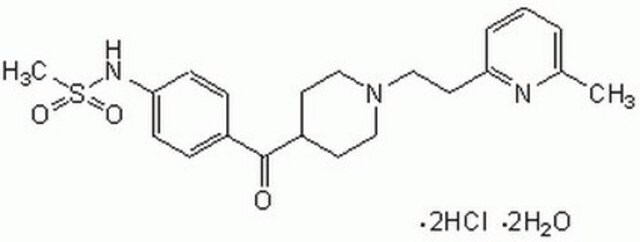SML2354
HMR-1556
≥98% (HPLC)
Synonyme(s) :
(3R,4S)-(+)-N-[3-Hydroxy-2,2-dimethyl-6-(4,4,4,-trifluorobutoxy)chroman-4-yl]-N-methylmethanesulfonamide, Chromanol HMR 1556, HMR 1556, HMR1556, N-[(3R,4S)-3,4-Dihydro-3-hydroxy-2,2-dimethyl-6-(4,4,4-trifluorobutoxy)-2H-1-benzopyran-4-yl]-N-methylmethanesulfonamide
Sélectionner une taille de conditionnement
169,00 $
Sélectionner une taille de conditionnement
About This Item
169,00 $
Produits recommandés
Essai
≥98% (HPLC)
Forme
powder
Activité optique
[α]/D +2 to +3.5°, c = 0.1 in methanol
Couleur
white to beige
Solubilité
DMSO: 2 mg/mL, clear
Température de stockage
2-8°C
Chaîne SMILES
CC1([C@@H]([C@H](C2=CC(OCCCC(F)(F)F)=CC=C2O1)N(C)S(C)(=O)=O)O)C
InChI
1S/C17H24F3NO5S/c1-16(2)15(22)14(21(3)27(4,23)24)12-10-11(6-7-13(12)26-16)25-9-5-8-17(18,19)20/h6-7,10,14-15,22H,5,8-9H2,1-4H3/t14-,15+/m0/s1
Clé InChI
SRZRLJWUQFIZRH-LSDHHAIUSA-N
Actions biochimiques/physiologiques
Code de la classe de stockage
11 - Combustible Solids
Classe de danger pour l'eau (WGK)
WGK 3
Point d'éclair (°F)
Not applicable
Point d'éclair (°C)
Not applicable
Faites votre choix parmi les versions les plus récentes :
Certificats d'analyse (COA)
Vous ne trouvez pas la bonne version ?
Si vous avez besoin d'une version particulière, vous pouvez rechercher un certificat spécifique par le numéro de lot.
Déjà en possession de ce produit ?
Retrouvez la documentation relative aux produits que vous avez récemment achetés dans la Bibliothèque de documents.
Active Filters
Notre équipe de scientifiques dispose d'une expérience dans tous les secteurs de la recherche, notamment en sciences de la vie, science des matériaux, synthèse chimique, chromatographie, analyse et dans de nombreux autres domaines..
Contacter notre Service technique







